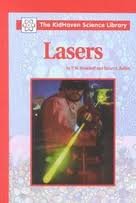-
The KidHaven Science Library - Thunderstorms
Patrica D Netzley
Library Binding (KidHaven Press, Nov. 22, 2002)Thunderstorms are an important, though sometimes frightening, part of the natural world. This book explains how thunderstorms form, tells about the forces that drive wind and rain, describes various types of thunderstorms, and discusses lightening and its dangers. Q
Q
-
The KidHaven Science Library - Lasers
Stuart A Kallen
Hardcover (KidHaven Press, Oct. 23, 2001)Lasers are used today in everything from CD players to satellites. Lasers, explores the scientific concepts behind these super tools in easy-to-understand language while exploring the history and development of these miraculous inventions. R
R
-
The KidHaven Science Library - Cells
Jeanne DuPrau
Hardcover (KidHaven Press, Oct. 23, 2001)The basic unit of all living things, the cell is a world in itself. This book explores the workings of plant and animal cells -- what they look like, how they're nourished, and how they reproduce. It also describes the role of disease cells in the human body, and how new knowledge about cells provides hope for the treatment of illnesses such as cancer and muscular dystrophy. R
R
-
The KidHaven Science Library - The Big Bang
Don Nardo
Hardcover (KidHaven Press, Jan. 11, 2005)Scientists believe that more than 13 billion years ago the universe was born in a titantic explosion-the Big Bang. It has been expanding ever since. This volume, aimed at basic readers, explores the evidence for this momentous event, as well as glances far ahead into alternate futures in which the universe either keeps expanding or reverses course and contracts. Q
Q
-
The KidHaven Science Library - Light
Bonnie Juettner
Hardcover (KidHaven Press, Oct. 1, 2003)Most of what scientists know about light they have figured out by observing the properties of light. Those properties, along with the fascinating effects and modern uses of light are discussed in this book. Full-color photographs and diagrams help readers understand this topic. Q
Q
-
The KidHaven Science Library - Germs
Don Nardo
Hardcover (KidHaven Press, Oct. 23, 2001)Germs are everywhere, this concise but information-packed volume tells young readers. The amply illustrated volume explores the physical makeup of germs; how they cause disease and how modern disease detectives identify them and work to prevent or contain disease epidemics; as well as useful germs and how they are used in such industries as food production and sewage treatment. Q
Q
-
The KidHaven Science Library - Tide Pools
Marcia S. Gresko
Hardcover (KidHaven Press, Oct. 23, 2001)Tide pools come in all shapes and sizes, and each is different. This book explores life in nature's aquariums -- home to an assortment of amazing animals and peculiar plants. R
R
-
The KidHaven Science Library - Volcanoes
Patricia D. Netzley
Library Binding (KidHaven Press, Dec. 13, 2002)Volcanoes have been erupting since the beginning of the Earth's formation. They have captured humankind's attention with their awesome power and beauty. This anthology covers the science and study of volcanoes, some of the major volcanic disasters, and some of what has been and is being developed to avert potential catastrophe. U
U
-
The KidHaven Science Library - Genetics
Buffy Silverman
Hardcover (KidHaven Press, Oct. 17, 2003)Genetics explains how living things pass on characteristics from one generation to the next. This book introduces young readers to modern genetics, from Gregor Mendel's study of pea plants to the cloning of Dolly the sheep. It also explores how mutations cause genetic diseases, the role genes may play in curing diseases, and the use of DNA fingerprints to identify criminals. M
M
-
The KidHaven Science Library - Computers
Roberta Baxter
Hardcover (KidHaven Press, Feb. 25, 2005)What's inside a computer? How does information get into and out of the computer? Can faster, more powerful computers be invented? These questions and more will be answered in Computers. Learn about computers from the gigantic machines with mechanical switches to the computers of today. U
U
-
The KidHaven Science Library - Telescopes
Don Nardo
Hardcover (KidHaven Press, July 1, 2005)In the early 1600s, the Italian mathematician Galileo became the first person to apply a new invention-the telescope-to study the heavens. This informative volume explains how telescopes work and traces their history, along with the major discoveries they made possible, from Galileo's time to the present. The final chapter deals with present and planned space telescopes. R
R
-
The KidHaven Science Library - Space Travel
Don Nardo
Hardcover (KidHaven Press, March 11, 2003)Human beings have dreamed about traveling beyond Earth for thousands of years. This fascinating volume tells about those early dreams, then examines the development of human flight, rockets, and the first space stations, as well as present plans for exploring the solar system, and the possibility that humans will someday reach planets orbiting other stars. Q
Q